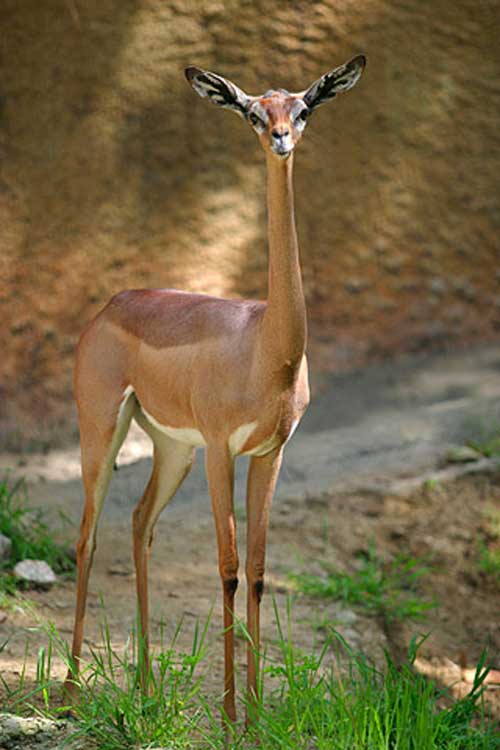Litocranius walleri (*) Cladus: Eukaryota References * Litocranius walleri on Mammal Species of the World. Name Litocranius walleri (Brooke, 1878) Vernacular names --------------- The Gerenuk (Litocranius walleri), also known as the Waller's Gazelle, is a long-necked species of antelope found in dry bushy scrub and steppe in East Africa. The word Gerenuk comes from the Somali language, meaning “giraffe-necked”, and leads to another common name, the Giraffe-necked Antelope. It is the only member of the genus Litocranius. Gerenuks have a small head for their body, but their eyes and ears are big. Unlike females, males have horns and a more muscular neck. They are brown on their back, and lighter underneath. They have short, black tails. From head to tail, the gerenuk is around 150 cm long. Males are a little taller than females, ranging from 89-105 cm, and the females are 80-100 cm. The male is also heavier than the female, weighing at 45 kg, and females are 30 kg. They can mate during any time of the year. Females reach sexual maturity at one year, and males reach sexual maturity at 1.5 years. The gestation period is about seven months. They are born one at a time, weighing about 3 kg at birth. Their life span is about eight years in the wild, but they can live thirteen years or more in captivity.[2] Subspecies * Southern Gerenuk Litocranius walleri walleri
1. ^ IUCN SSC Antelope Specialist Group (2008). Litocranius walleri. In: IUCN 2008. IUCN Red List of Threatened Species. Downloaded on 29 March 2009. Database entry includes a brief justification of why this species is of near threatened. * Sanderson, Ivan T. (1970). Knaurs Tierreich in Farben: Säugetiere. Deutscher Bücherbund. Source: Wikispecies, Wikipedia: All text is available under the terms of the GNU Free Documentation License |
|


